Vivariums vs. Terrariums: Understanding the Key Differences
Danny PhamShare
What is a Vivarium? Are there any differences between Vivarium vs Terrarium?
A vivarium is a type of enclosure or habitat that is designed to house and support the life of living organisms, typically animals or plants. The term "vivarium" comes from the Latin word "vivere," which means "to live." Vivariums are often used in research, education, and as a way for people to observe and interact with various forms of life in a controlled environment.
Vivariums can take on many different forms, ranging from small desktop setups to large, complex ecosystems that mimic natural habitats. They can be used to house a wide variety of living creatures, including reptiles, amphibians, small mammals, birds, insects, and even some types of plants.
The main purpose of a vivarium is to provide a safe and healthy environment for the organisms that live within it. This involves carefully controlling factors such as temperature, humidity, lighting, and substrate to create conditions that closely match the natural habitat of the species being housed. By doing so, the animals or plants can thrive and exhibit natural behaviors, allowing for a more enriching and educational experience for the observer.
The Problem With the Term "Vivarium"
While the term "vivarium" is commonly used to refer to a wide range of enclosures, it can be a bit misleading. The term "vivarium" is often used interchangeably with other similar terms, such as "terrarium," "aquarium," and "paludarium," each of which has its own distinct characteristics and requirements.
The problem with using the term "vivarium" as a catch-all phrase is that it can lead to confusion and a lack of understanding about the specific needs and requirements of the different types of enclosures. For example, a vivarium designed for a reptile may have very different environmental conditions than one designed for an aquatic species, and the care and maintenance required for each can vary significantly.
To avoid this confusion, it's important to understand the differences between the various types of "ariums" and to use the correct terminology when referring to specific enclosures. In the following sections, we'll explore the key differences between terrariums, vivariums, and other related types of enclosures.
5 Key Differences Between Terrariums vs Vivariums
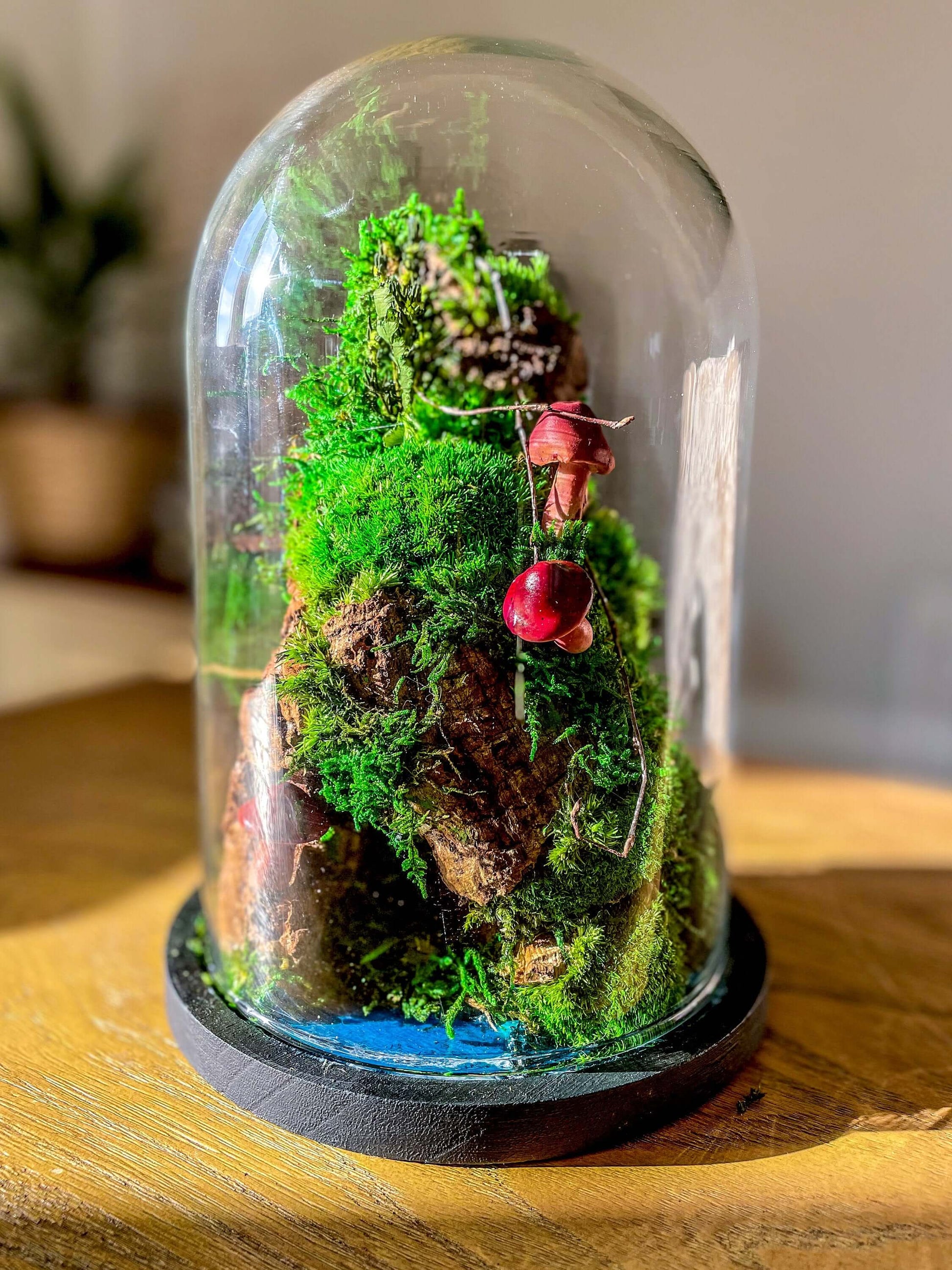
A display terrarium

A vivarium
While terrariums and vivariums are often used interchangeably, there are some important differences between the two:
- Purpose: Terrariums are primarily designed to house and display plants, while vivariums are designed to house and support the life of living animals, such as reptiles, amphibians, or invertebrates.
- Environment: Terrariums typically have a more closed, self-contained environment, with a focus on creating the optimal conditions for plant growth. Vivariums, on the other hand, are designed to mimic the natural habitat of the animals they house, with a greater emphasis on factors such as temperature, humidity, and airflow.
- Maintenance: Terrariums generally require less ongoing maintenance than vivariums, as the plants within them can often thrive with minimal intervention. Vivariums, however, require more regular monitoring and adjustment to ensure the animals' needs are being met.
- Complexity: Vivariums tend to be more complex in terms of their design and the number of components required, such as lighting, heating, and water sources. Terrariums can be simpler and may only require a basic lighting setup and occasional watering.
- Inhabitants: As mentioned, terrariums are primarily designed for plants, while vivariums are designed for animals. The specific animals that can be housed in a vivarium will depend on the size and setup of the enclosure, as well as the species' individual needs.
It's important to note that there can be some overlap between terrariums and vivariums, and in some cases, the terms may be used interchangeably. However, understanding the key differences can help ensure that the appropriate enclosure is selected and maintained to provide the best possible environment for the living organisms it is designed to house.
Main Types Of Vivariums
Vivariums come in a variety of forms, each with its own unique characteristics and requirements. Here are some of the main types of vivariums:
Vivariums: Everything You Need To Know
Vivariums, in the strictest sense, are enclosures designed to house and support the life of terrestrial or semi-aquatic animals, such as reptiles, amphibians, or invertebrates. These enclosures are typically set up to mimic the natural habitat of the species being housed, with a focus on providing the appropriate environmental conditions, such as temperature, humidity, and substrate.
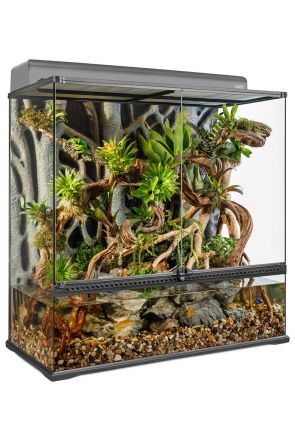
A vivarium tank
Key Features of Vivariums:
- Designed to house terrestrial or semi-aquatic animals
- Focused on creating the optimal environmental conditions for the species
- May include a range of features, such as hiding spots, climbing structures, and water sources
- Require regular monitoring and adjustment to maintain the appropriate conditions
Examples of Animals Commonly Kept in Vivariums:
- Lizards (e.g., geckos, anoles, skinks)
- Snakes (e.g., corn snakes, ball pythons)
- Amphibians (e.g., frogs, salamanders)
- Invertebrates (e.g., tarantulas, scorpions)
Aquarium: Everything You Need To Know
Aquariums are a type of vivarium that is designed to house aquatic organisms, such as fish, aquatic plants, and other water-dwelling creatures. These enclosures are typically filled with water and are designed to mimic the natural habitat of the species being housed, with a focus on factors like water quality, filtration, and lighting.
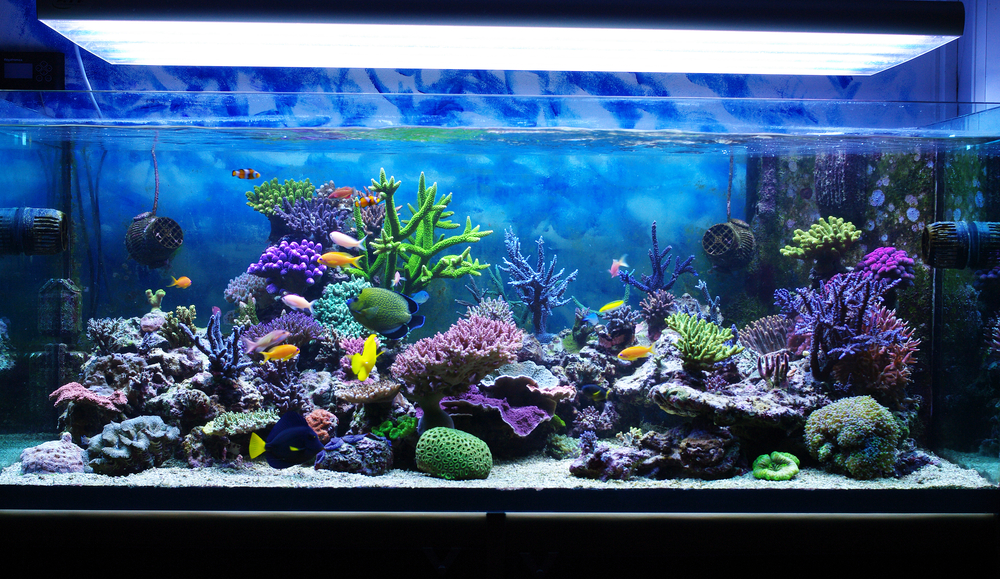
An aquarium tank
Key Features of Aquariums:
- Designed to house aquatic organisms, such as fish and aquatic plants
- Filled with water and focused on creating the optimal aquatic environment
- May include features like filtration systems, lighting, and substrate
- Require regular water testing and maintenance to ensure the health of the inhabitants
Examples of Animals Commonly Kept in Aquariums:
- Tropical fish (e.g., guppies, tetras, cichlids)
- Freshwater invertebrates (e.g., shrimp, snails)
- Aquatic plants (e.g., Java moss, anubias, cryptocoryne)
Paludarium: Everything You Need To Know
A paludarium is a type of vivarium that combines both aquatic and terrestrial elements, creating a unique environment that can support a diverse range of organisms. These enclosures typically feature a water feature, such as a pond or stream, along with a terrestrial area for plants and animals.
Check out our paludarium guide here.

A paludarium tank
Key Features of Paludariums:
- Combines both aquatic and terrestrial elements
- May include a water feature, such as a pond or stream, along with a terrestrial area
- Designed to support a diverse range of organisms, including aquatic and semi-aquatic species
- Requires careful balancing of environmental factors, such as temperature, humidity, and lighting
Examples of Animals Commonly Kept in Paludariums:
- Amphibians (e.g., frogs, newts, salamanders)
- Semi-aquatic reptiles (e.g., turtles, water snakes)
- Aquatic plants (e.g., water lilies, anubias)
- Terrestrial plants (e.g., bromeliads, ferns)
Riparium: Everything You Need To Know
A riparium is a type of aquarium that is designed to mimic the natural environment of a river, stream, or other freshwater habitat. These enclosures typically feature a water feature, such as a flowing stream or waterfall, along with a variety of aquatic and semi-aquatic plants.
Key Features of Riariums:
- Designed to mimic the natural environment of a river, stream, or other freshwater habitat
- May include a water feature, such as a flowing stream or waterfall
- Focused on housing a variety of aquatic and semi-aquatic plants
- Requires careful balancing of environmental factors, such as water flow, lighting, and substrate
Examples of Animals Commonly Kept in Riariums:
- Freshwater fish (e.g., tetras, danios, rasboras)
- Aquatic invertebrates (e.g., shrimp, snails)
- Semi-aquatic plants (e.g., water lily, water hyacinth, Java moss)
Terrarium: Everything You Need To Know
Terrariums are a type of enclosure that is designed to house and display plants, rather than animals. These enclosures are typically more closed and self-contained than vivariums, and are focused on creating the optimal conditions for plant growth and display.
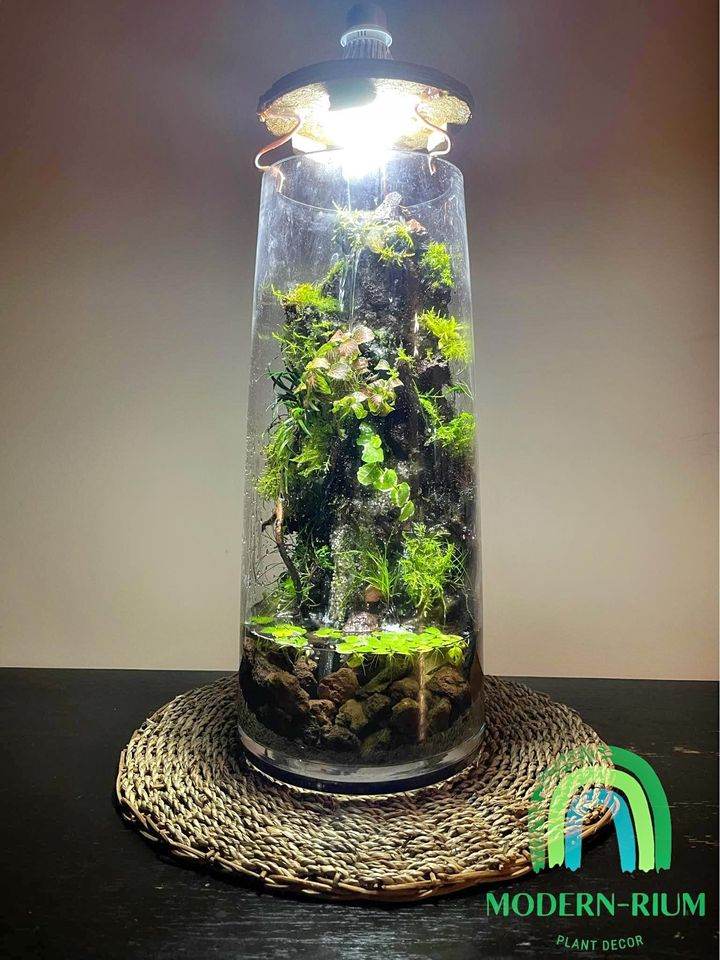
A tall terrarium jar
Check out our full terrarium care guide here.
Key Features of Terrariums:
- Designed to house and display plants
- Typically more closed and self-contained than vivariums
- Focused on creating the optimal conditions for plant growth and display
- May include features like lighting, substrate, and water sources
Examples of Plants Commonly Kept in Terrariums:
- Succulents (e.g., echeveria, jade plant, aloe vera)
- Ferns (e.g., maidenhair fern, staghorn fern)
- Mosses (e.g., sheet moss, cushion moss)
- Carnivorous plants (e.g., Venus flytrap, pitcher plant)
Formicarium: Everything You Need To Know
A formicarium is a type of vivarium that is specifically designed to house and support the life of ants and other social insects. These enclosures are typically complex and multi-chambered, with features like tunnels, nesting areas, and foraging zones.

A small ant formicarium
Key Features of Formicariums:
- Designed to house and support the life of ants and other social insects
- Often complex and multi-chambered, with features like tunnels, nesting areas, and foraging zones
- Require careful monitoring and maintenance to ensure the health and well-being of the inhabitants
- May include features like humidity and temperature control, as well as food and water sources
Examples of Insects Commonly Kept in Formicariums:
- Ants (e.g., carpenter ants, fire ants, leafcutter ants)
- Termites
- Bees
Mossarium: Everything You Need To Know
A mossarium is a type of terrarium that is specifically designed to showcase the beauty and diversity of moss species. These enclosures are typically more closed and self-contained than traditional terrariums, with a focus on creating the optimal conditions for moss growth and display.

A mossarium jar
Key Features of Mossariums:
- Designed to showcase the beauty and diversity of moss species
- Typically more closed and self-contained than traditional terrariums
- Focused on creating the optimal conditions for moss growth and display
- May include features like humidity and lighting control, as well as specialized substrates
Examples of Moss Species Commonly Kept in Mossariums:
- Fern moss (Thuidium delicatulum)
- Hypnum moss (Hypnum cupressiforme)
- Leucobryum moss (Leucobryum glaucum)
- Sphagnum moss (Sphagnum spp.)
Bantamarium: Everything You Need To Know
A bantamarium is a type of vivarium that is specifically designed to house and support the life of bantam chickens or other small poultry species. These enclosures are typically larger and more complex than traditional vivariums, with features like nesting areas, roosting perches, and outdoor runs.
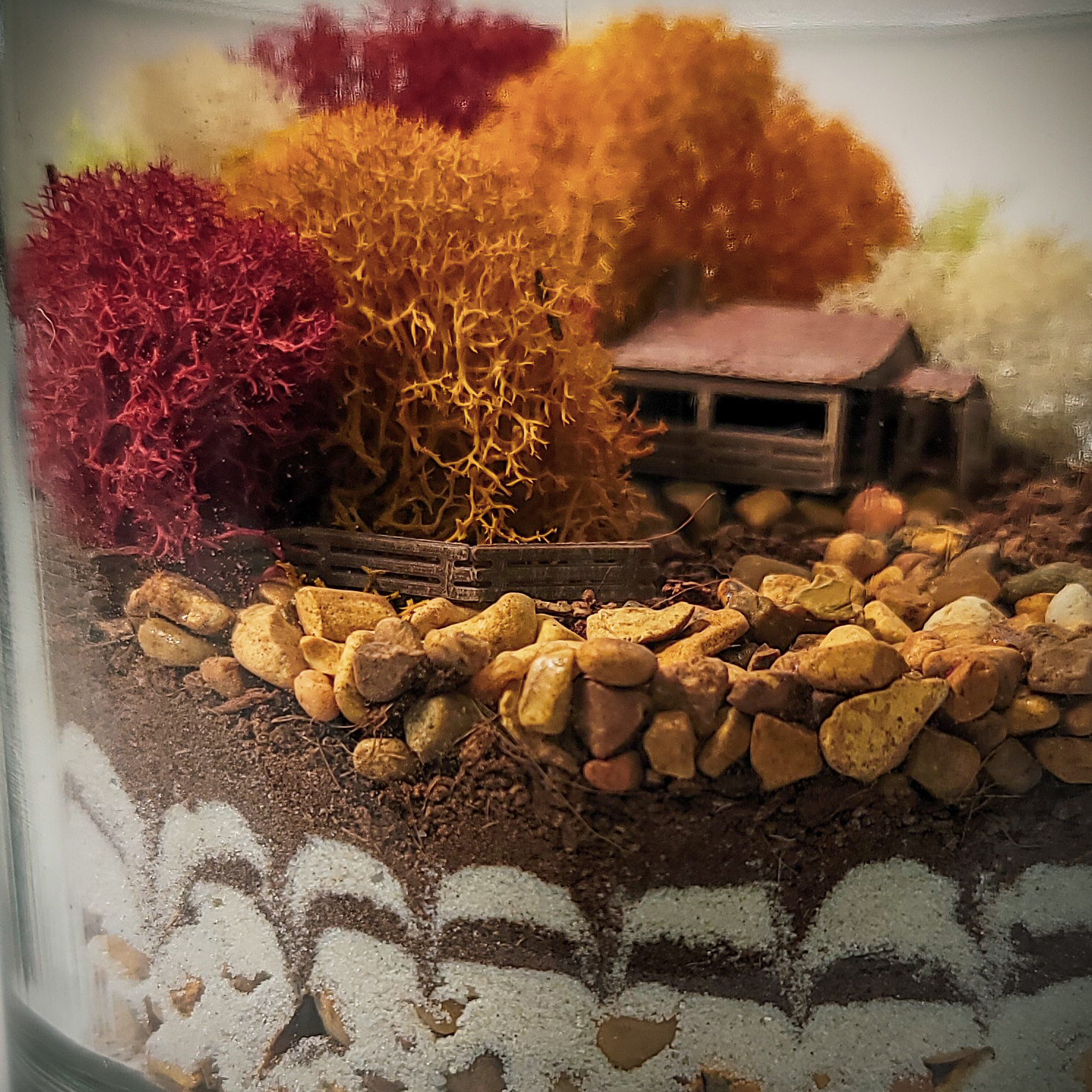
A bantamarium
Key Features of Bantamariums:
- Designed to house and support the life of bantam chickens or other small poultry species
- Typically larger and more complex than traditional vivariums
- May include features like nesting areas, roosting perches, and outdoor runs
- Require careful monitoring and maintenance to ensure the health and well-being of the inhabitants
Examples of Poultry Species Commonly Kept in Bantamariums:
- Bantam chickens (e.g., Silkie, Cochin, Wyandotte)
- Quail
- Ducks (e.g., Call ducks, Pekins)
Popular animals for vivarium tanks
Vivariums can be home to a wide variety of animals, from reptiles and amphibians to small mammals and invertebrates. Here are some of the most popular animals that are commonly kept in vivarium tanks:
Reptiles:
- Geckos (e.g., leopard geckos, crested geckos, day geckos)
- Anoles (e.g., green anoles, brown anoles)
- Skinks (e.g., blue-tongued skinks, fire skinks)
- Snakes (e.g., corn snakes, ball pythons, milk snakes)
- Chameleons
- Lizards (e.g., tegus, uromastyx)
Amphibians:
- Frogs (e.g., dart frogs, tree frogs, pacman frogs)
- Salamanders (e.g., fire salamanders, axolotls)
- Newts (e.g., rough-skinned newts, Japanese fire-bellied newts)
Invertebrates:
- Tarantulas
- Scorpions
- Millipedes
- Isopods (e.g., pill bugs, woodlice)
- Praying mantises
- Beetles (e.g., rhinoceros beetles, stag beetles)
Small Mammals:
- Hamsters
- Gerbils
- Mice
- Degus
- Chinchillas
When selecting animals for a vivarium, it's important to carefully research the specific needs and requirements of each species to ensure that the enclosure is properly set up and maintained. Factors like temperature, humidity, lighting, and substrate can all have a significant impact on the health and well-being of the animals being housed.
Conclusion
In conclusion, a vivarium is a type of enclosure or habitat that is designed to house and support the life of living organisms, typically animals or plants. While the term "vivarium" is often used interchangeably with other similar terms, such as "terrarium" and "aquarium," it's important to understand the key differences between these various types of enclosures in order to ensure that the appropriate setup is provided for the specific species being housed.
By understanding the different types of vivariums, their key features, and the animals and plants that can be housed within them, you can create a thriving and enriching environment that allows for the observation and enjoyment of a wide range of living creatures. Whether you're interested in keeping reptiles, amphibians, invertebrates, or even small mammals, there's a vivarium solution that can meet your needs and provide a safe and healthy home for your chosen species.
Frequently Asked Questions
1. What is the difference between a terrarium and a vivarium?
The main difference between a terrarium and a vivarium is that a terrarium is designed to house and display plants, while a vivarium is designed to house and support the life of living animals, such as reptiles, amphibians, or invertebrates.
2. Can I keep multiple species in a vivarium?
It is generally not recommended to keep multiple species in the same vivarium, as this can lead to stress, competition, and potential conflict between the animals. It's best to house only one species per vivarium, or to carefully research any potential compatible species before attempting to house them together.
3. How do I maintain the proper temperature and humidity in a vivarium?
Maintaining the proper temperature and humidity in a vivarium is crucial for the health and well-being of the animals being housed. This typically involves the use of specialized equipment, such as thermostats, hygrometers, and heating/cooling devices, as well as regular monitoring and adjustment to ensure the enclosure remains within the ideal range for the specific species.
4. What kind of lighting do I need for a vivarium?
The type of lighting required for a vivarium will depend on the specific species being housed, as well as the overall design of the enclosure. Some common lighting options include UVB lighting for reptiles, LED or fluorescent lighting for plants, and specialized lighting for aquatic habitats.
5. How often do I need to clean a vivarium?
The frequency of cleaning a vivarium will depend on factors like the size of the enclosure, the number and type of animals or plants being housed, and the overall maintenance routine. As a general rule, it's recommended to perform a partial clean-up on a weekly basis, with a more thorough clean every 4-6 weeks.
 is here! Shop now, pay later in 4 easy installments
is here! Shop now, pay later in 4 easy installments











